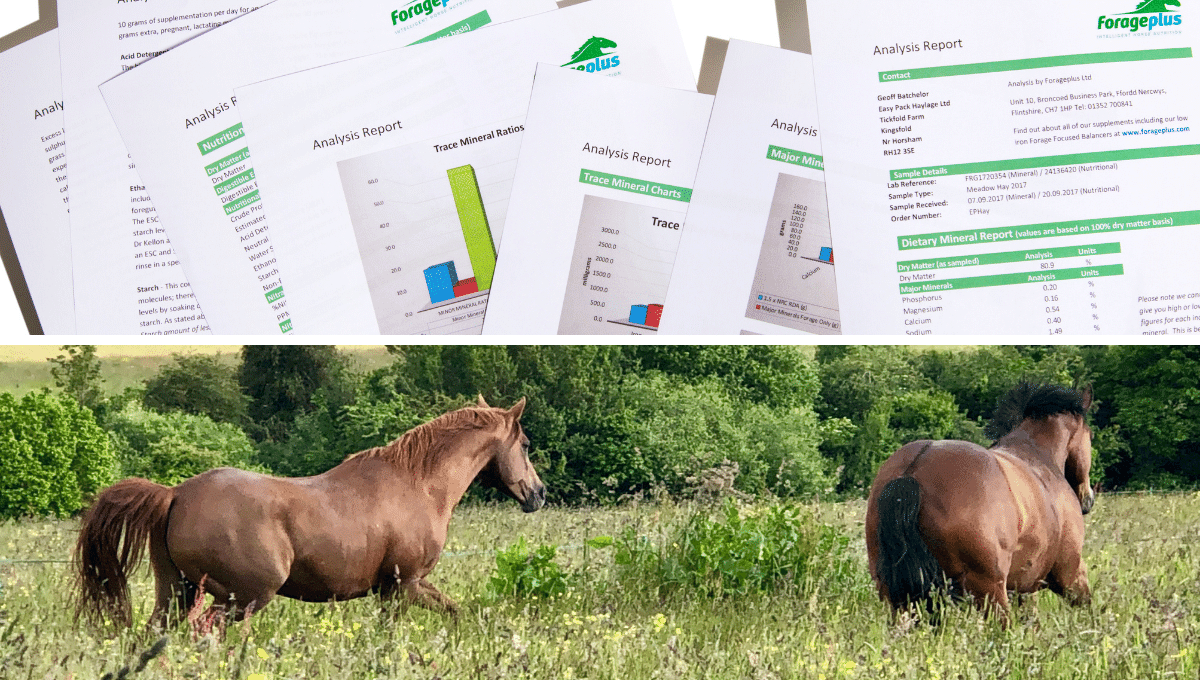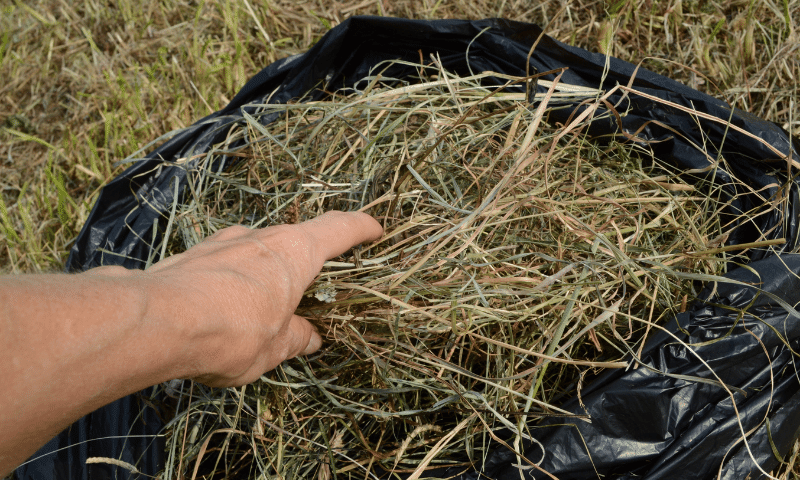Would you like to further understand a nutritional and mineral analysis report of horse grass, hay and haylage? Carrying out testing of the forage horses eat is a very useful way of checking the nutritional elements in the horse diet.
Analysis can help you understand if hay is suitable for laminitis prone horses, ponies and donkeys. Analysis can also help you understand if the balance of minerals and the quality of protein is right in the grass, hay or haylage you feed to your horse.
Feeding your horse like a horse, the way nature intended, means feeding the most nutritious diet possible through a high fibre, high forage diet. Some horses will do well on ad-lib grass, hay or haylage, regulating their intake and eating only what they need to maintain good body weight. This type of feeding mimics a natural grazing pattern and behaviour. Other horses seem not to be able to regulate intake and will need restricted feeding to control body weight at a safe level.
Analysis of the forage a horse or pony eats, through laboratory testing, will lead you to be more confident in knowing just what you need to feed your horse. You will know just how much hay or haylage they need and just what extra supplements need to be added to match this greatest proportion and foundation of a healthy horse diet.
Terms to Understand on Forage Analysis for Horses
Moisture: the per cent water in a sample.
Dry Matter: equals (100% – Moisture) and represents everything in the sample other than water including protein, fibre, fat, minerals, etc.. Animals consume feeds to meet their dry matter needs, because it is the dry matter that contains all of the nutrients. Therefore, animals will have to consume more of a wetter feed to receive the same amount of dry matter as they would from a drier feed. For example, if an animal consumes 10 kg of hay at 90% dry matter, it consumes 9 kg of dry matter (10 x .90). If pasture at 20% dry matter is substituted for the hay, it would have to consume 45 kg. of pasture (9/.20) to receive the same amount of dry matter.
Hay has the highest dry matter content of the forage fed to horses and ponies. Haylage can have a dry matter content some 30% lower than hay so a greater weight of haylage often needs to be fed in comparison to hay because there is more water in haylage. Thus, it is very important to know the dry matter content of a feed to establish feeding rates and ensure that livestock receives the proper amount of feed to meet their daily needs.
As Sampled Basis: nutrient results for a sample in its natural state including the water. Also known as fed or as received.
Dry Matter Basis: nutrient results for the sample with the water removed. There is considerable variation in the moisture content of forages. Removing the water eliminates its dilution effect, thereby enabling direct comparisons of nutrient contents across different forages. For example, suppose that you wanted to compare the protein content of a hay testing 90% dry matter to a pasture testing 20% dry matter.
On an as sampled basis, the hay tested 14% crude protein (CP) and the pasture 5% CP. The hay appears to have a higher CP level. However, removing the dilution effect of the water reveals that the hay is 15.5% CP (14/.90) and the pasture is 25% CP (5/.20) on a dry matter basis. Thus, removing the dilution effect of the water revealed that per pound of dry matter, the pasture is higher in protein. Animals eating the pasture will consume more protein per pound of dry matter than they will from the hay.
Livestock nutrient requirements may be expressed on either a sampled or dry matter basis. It is important to use analytical results expressed on the same basis as the nutrient requirements. In general, most livestock requirements are expressed on a dry matter basis, therefore the forage results on a dry matter basis should be used to balance the daily feed. Again, the key point is to make sure that the requirements and results are expressed on the same basis.
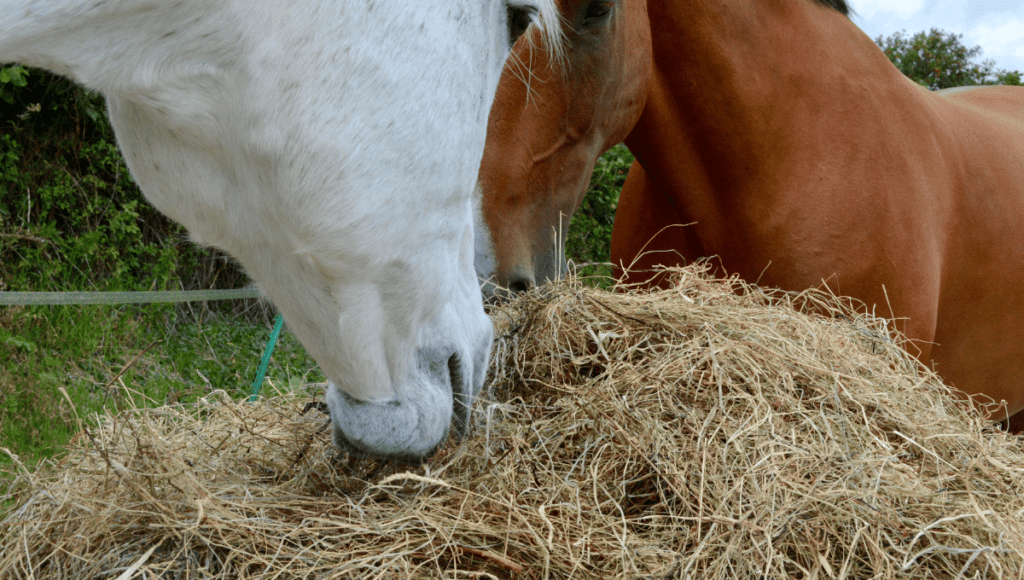
What does Forageplus Nutritional Analysis for Horses Tell You?
Digestible Energy DE: the energy that is digested and absorbed by the animal. Another way of thinking about DE is to use the term calories. It is determined by subtracting the energy contained in the faeces from the gross energy. In horses, the faecal energy loss is typically 35 – 40% of the gross energy. Energy is the nutrient required in the greatest amount. Energy is used in all biological processes and is essential for life.
For horses, energy requirements are determined for maintenance, growth or gain, lactation, reproduction and activity level. Failure to supply adequate energy will result in poor performance. Energy values are not measured, rather they are predicted using equations and relationships with other nutrients. The Forageplus Nutritional Analysis for horses uses a multiple component summative approach in its energy prediction system. Energy contributions from protein, fibre, nonstructural carbohydrates and fat form the foundation of the system. Discounts are applied to reflect energy available for productive purposes.
The DE value is used to balance the energy portion of the equine diet. Energy requirements are expressed as mega calories (Mcal) or megajoules (MJ). It is highly useful to know the DE of hay or haylage to enable you to maintain the correct weight for the good doer and poor doer horses. Good doer horses can weight forage-fed restricted so that careful and slow weight loss is actioned. Poor doer horses can be fed a weight of hay to encourage weight gain or a bucket feed can be calculated against the DE of the forage and used to boost the calories available in the diet.
Crude Protein (CP): an estimation of total protein based on the amount of nitrogen in the hay. It does not tell you anything about the amino acid composition or the protein quality. Many forages particularly those which have been fertilised with an NPK fertiliser can have amino acids which are poorly formed. This leads to some of the essential amino acids being unavailable to horses.
Proteins are organic compounds composed of amino acids. They are a major component of vital organs, tissue, muscle, hair, skin, milk and enzymes. Protein is required daily for maintenance, lactation, growth and reproduction. If your horse has skin issues, poor hoof health, cracks and white line disease, and or lethargy problems and you have addressed minerals in the diet so that they are forage focused you may be looking at a protein deficiency. These issues can often be helped by improving the quality of protein and or level of protein in the diet.
Lysine (Lys): an indispensable amino acid required for growth in the young horse and the maintenance of health in the adult horse. This amino acid is often short in grass, hay and haylage and usually needs supplementing to all horses and ponies.
Acid Detergent Fibre (ADF) and Neutral Detergent Fibre (NDF): measure fibres (there are 5 types) which give the grass rigidity enabling it to support itself as it grows, much like the skeleton in animals. NDF can be negatively correlated with intake. Since fibres are digested by the microbes living in the hindgut (cecum and large colon), a healthy microbial population is important to allow your horse to derive calories from fibre. However, there is one type of fibre that is indigestible—lignin; the lignin ends up as manure. Lignin content increases as the plant matures. The higher these two values (ADF and NDF), the more lignin the hay contains, the less likely it is that your horse can thrive on this hay. The ideal ADF is less than 35%; the ideal NDF is less than 45%. Most hays have values 10 points or higher than these desired levels. To compensate, hay with a high ADF and or NDF needs to be consumed at a higher level. This can be easily solved by allowing your horse to have free access to hay 24 hours a day. However, if you have a horse that struggles to maintain weight then you need to be aware that a high ADF or NDF value will mean less energy and calories will extract from the hay. Conversely, hays with a high lignin content are useful for horses and ponies who are good-doers.
Water-Soluble Carbohydrates (WSC): Includes monosaccharides, disaccharides and some polysaccharides (mainly fructan). WSC measures these simple sugars and fructan levels. Simple sugars are digested in the foregut and raise insulin levels. Too much can lead to laminitis because of elevated blood insulin.
It has been thought in the past that fructan can contribute to laminitis, however, the amount of fructan contained in the pasture is not a problem so it is now thought that the levels of simple sugar and starch are the figures to be aware of when trying to control laminitis in horses. You should try to obtain nutritional analysis which distinguishes from simple sugars and fructans when determining whether hay is suitable for feeding to laminitis prone horses, ponies and donkeys.
Ethanol-Soluble Carbohydrates: a subset of WSC which includes primarily monosaccharides and disaccharides, without the fructan fraction. This gives you a better idea of the simple sugar level to determine if this hay is suitable for feeding to laminitis prone horses, ponies and donkeys.

Purely the testing WSC or NSC levels can mean that many perfectly safe hays are ruled out as being unsuitable. Where hay is difficult to source this can lead to owners over-looking forage which is perfectly safe to feed to laminitis prone horses and ponies or soaking hay that does not need to be soaked.
If you have a laminitic horse you should be concerned with the combined ESC and Starch level. The ideal level Dr Kellon and the ECIR Cushings Group have found for managing laminitic horses is an ESC and Starch combination of below 10%.
Rinsing hay will reduce the sugar but you need to rinse in a specific way. It is always better not to soak or rinse hay if you do not need to so you don’t remove water-soluble nutrients of benefit to animals.
Starch: normally digested in the foregut down to individual glucose (blood sugar) molecules; therefore, it has a strong elevating effect on blood insulin levels. You cannot lower starch levels by soaking or rinsing hay or haylage. It is therefore wise to feed hay that is low in starch to horses, ponies and donkeys who are prone to laminitis.
What does a Forageplus Full Mineral Analysis for Horses Tell You?
Minerals: Keep in mind that as minerals pass along the digestive tract the absorption process means that many minerals interact with one another, interfering with absorption. The easiest way to understand this is to imagine the minerals are balls in a lottery machine, too many of one colour ball will result in that ball having an unfair advantage in dropping down the shoot. So if you have a hundred blue balls and only 10 red balls the chances of a red ball dropping down the shoot (being absorbed) will be 10:1. If the correct ratio should be 2:1 then you will have a deficiency occurring which cumulatively over time will result in a greater and greater deficiency.
Calcium to Phosphorus Ratio: There needs to be more calcium than phosphorus in the hay. Most grass, hay and haylage will have more calcium than phosphorous in the UK and Europe, with the majority of hays supplying too much calcium in relation to phosphorous. The ideal ratio is 2:1, but the level of calcium can be even higher and still be considered safe. Phosphorus concentration must never be higher than calcium levels.
Calcium to Magnesium Ratio: Ideally, calcium content should not be more than twice that of magnesium. Most grass, hay and haylage tested at Forageplus has around 3 to 4 times the amount of calcium needed to match magnesium. Most forage has a magnesium level that is lower than the amount horses ideally require to balance to calcium. Furthermore, magnesium is not well absorbed, so supplementing is usually suggested to match the majority of grass, hay and haylage eaten by horses.
Iron, Zinc, Copper, and Manganese: ratios are Iron: Copper 4:1; Copper: Zinc: Manganese 1:4:4; although Dr Kellon likes to supplement at 1:3:3
Selenium: This is worth analysing since selenium has a narrow range of safety (1 to 5 mg per day). Too little can be just as damaging as too much, so know your hay’s selenium level before you supplement. In the UK and Europe, there are pockets of areas where selenium is can present at a high level in grass, hay and haylage. In most areas, the levels are extremely low.
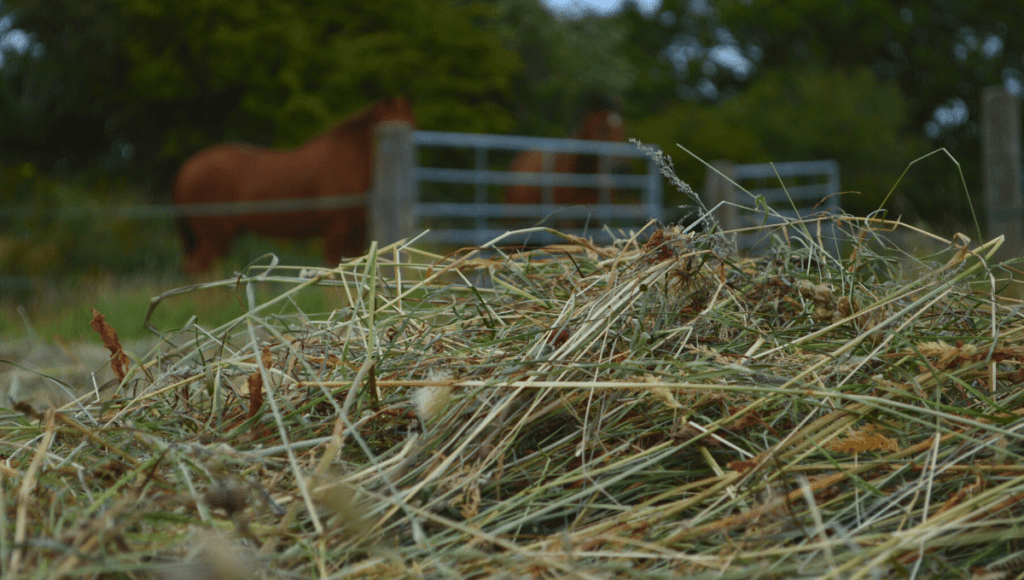
Mineral Levels Reported in a Forageplus Mineral Analysis Report
Calcium (Ca): bone and teeth formation, blood clotting, muscle contractions, milk component, the transmission of nerve impulses, cardiac regulation, activation and stabilisation of enzymes.
Phosphorus (P): bone and teeth formation, a key component of energy metabolism, milk component, body fluid buffer systems.
Magnesium (Mg): enzyme activator, found in skeletal tissue and bone, neuromuscular transmissions, crucial for good metabolic function.
Potassium (K): osmotic pressure regulation and water balance, electrolyte balance, acid-base balance, enzyme activator, muscle contraction, nerve impulse conductor.
Sodium (Na): acid-base balance, muscle contraction, nerve transmission, maintenance of body fluid balance, osmotic pressure regulator, cellular uptake of glucose, amino acid transport.
Iron (Fe): haemoglobin and oxygen transport, enzyme systems.
Zinc (Zn): enzyme activator, wound healing, skin/keratin health, immune system, liver health.
Copper (Cu): required for haemoglobin synthesis, coenzyme functions, liver health and crucial keratin health along with zinc.
Manganese (Mn): growth, bone formation, enzyme activator, fertility.
Molybdenum (Mo): part of enzyme xanthine oxidase, antagonistic and interactive effects with copper and sulphur.
Sulphur (S): present in insulin, biotin, thiamin, heparin and chondroitin sulfate.
Chloride (Cl): acid-base balance, osmotic pressure regulation, component of gastric secretions.
Cobalt (Co): required for vitamin B12 synthesis.
Selenium (Se): component of glutathione peroxidase enzyme, antioxidant properties, prevention of white muscle disease and retained placenta.
Iodine (I): Essential for the synthesis of the thyroid hormones thyroxine (T4) and triiodothyronine (T3) that regulate basal metabolism.
Testing for Nitrates in Horse Hay and Haylage
When both a nutritional and full mineral analysis of hay or haylage is carried out then a calculation to determine the ratio between nitrogen and sulphur can be carried out. This ratio indicates the quality of protein and whether the protein contains high levels of non-nitrate protein.
Nitrates (N03): can become a problem when fed in high amounts. Drought, frost, incorrect fertilization and manure application practices are factors that can lead to high nitrate levels. When nitrate is converted to nitrite, it impedes the uptake of oxygen by the blood resulting in death due to lack of oxygen. Blood becomes brownish in colour and exterior membranes may become bluish in colour.
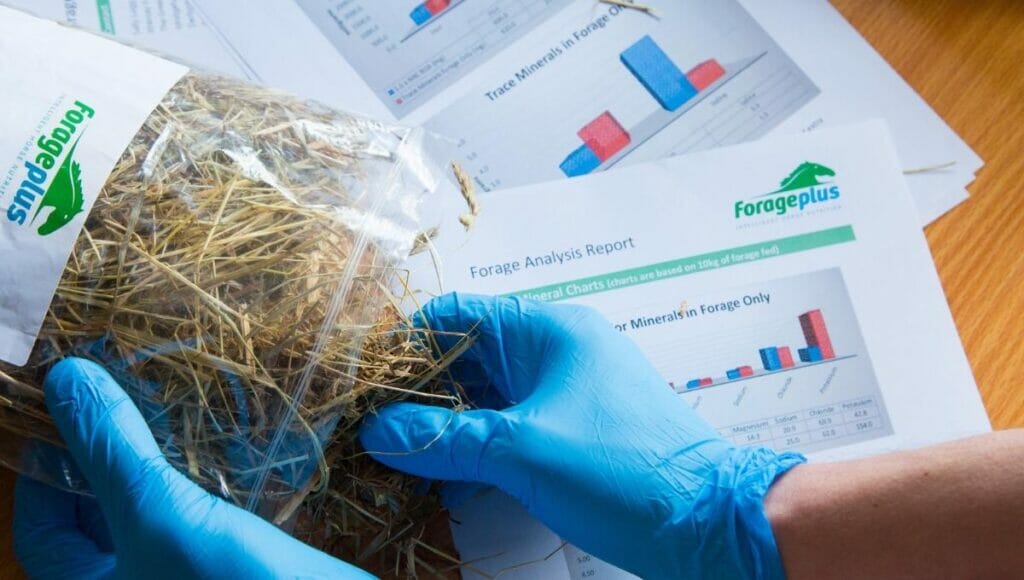
View our full range of analysis services here

